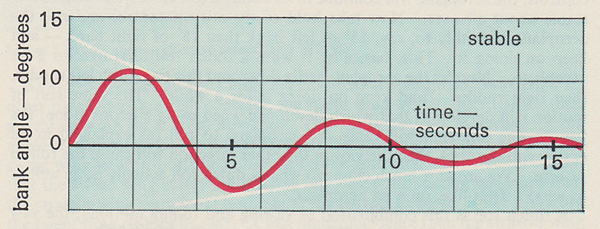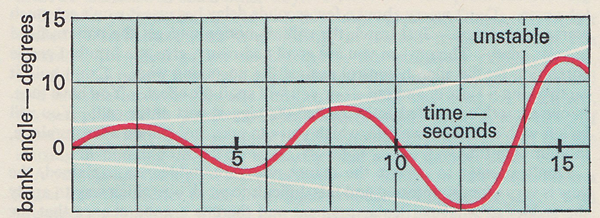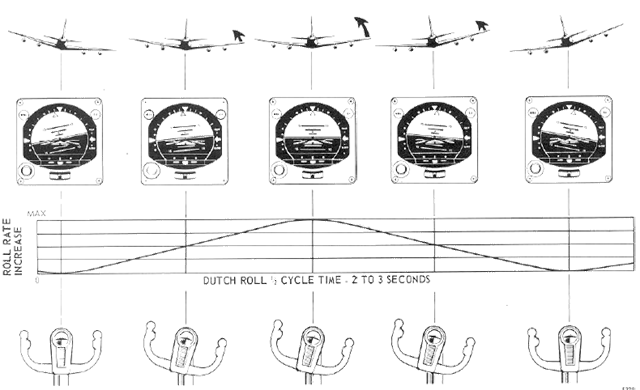Between June 27, 1958 and January 14, 1999, there had been 74 crashes of KC-135 aircraft and the few related models used by the U.S. Air Force. That's nearly two a year. Several of those could be attributed to the airplane's negative lateral stability and absence of a yaw damper. KC-135A crews had to be experts on the subject of dutch roll.
— James Albright

Updated:
2014-03-22
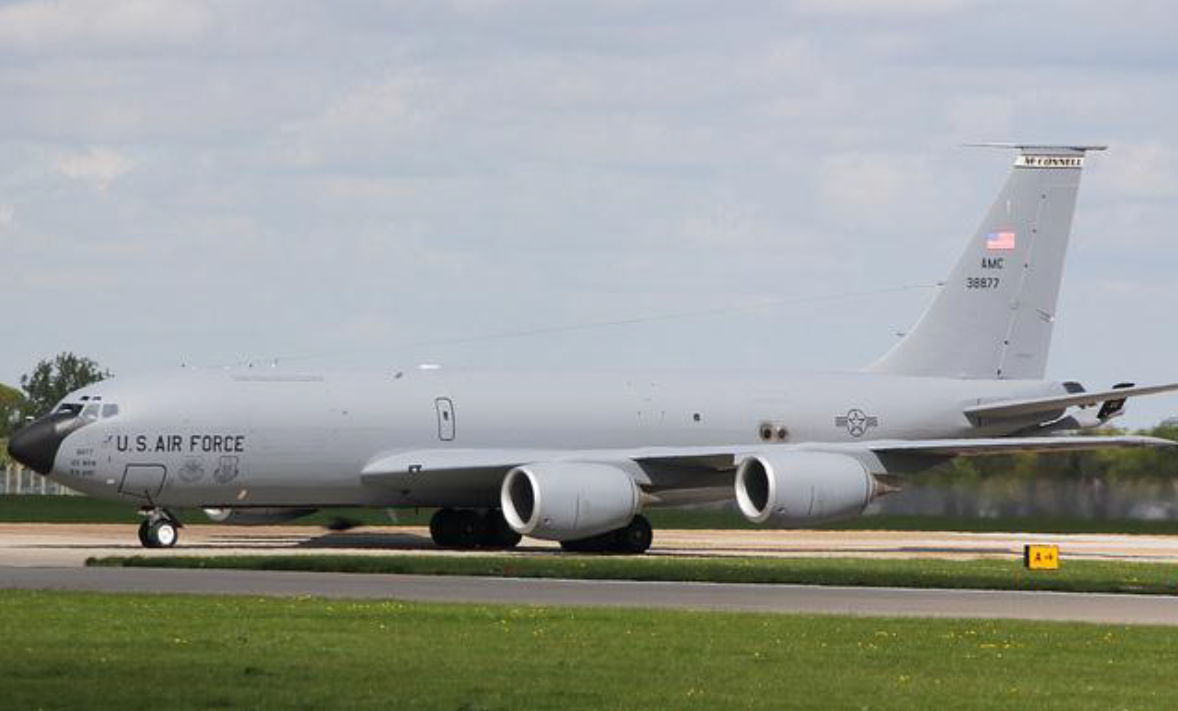
KC-135R 63-8877,
from Accident Investigation Report, cover.
Right around 1999 most of the aircraft were fitted with modern avionics, better engines, and a very good yaw damper. Since then only two have been lost, one of those in 2006 when it was struck while sitting on a taxiway by another airplane on takeoff roll. The most recent, as of this writing, was in 2013 due to dutch roll. As is true with most modern aircraft, yaw dampers have made dutch roll techniques obsolete. As this mishap demonstrates, recognizing and defeating a dutch roll is a good skill to have. Most pilots have never encountered dutch roll and may not be able to recognize its symptoms. The key point here is that dutch roll is best handled with ailerons only. More about this: Stability and Control.

1
Accident report
- Date: 3 May 2013
- Type: Boeing KC-135R Stratotanker
- Operator: United States Air Force - USAF
- Registration: 63-8877
- Fatalities: 3 of 3 crew
- Aircraft Fate: Destroyed
- Phase: En route
- Airports: (Departure) Bishkek-Manas International Airport (FRU/UCFM), Kyrgyzstan; (Destination) Bishkek-Manas International Airport (FRU/UCFM), Kyrgyzstan
2
Narrative
Note: the USAF accident report is filled with unnecessary acronyms which make for some laborious reading. Where possible, I've tried to cut through that and my edits are apparent within [brackets].
- The [crew] stepped to the [aircraft] on time to begin their preflight. While in the [aircraft], the [crew] encountered a weather [Radar] fault that would cause the power to cycle on and off throughout the flight. The [crew] accomplished engine start at 1417L.
- At 1428L, the [crew taxied] on the runway and lined up for departure. Just prior to obtaining takeoff clearance, the [crew] attempted to troubleshoot the intermittent [radar] system; eventually, the [crew] elected to continue the mission with the system inoperative. The [crew] departed at 1437L, 18 minutes prior to the scheduled departure time of 1455L. Immediately after takeoff, the [pilot] and [copilot] experienced an unexpected rapid heading change known as a crab in which the [aircraft’s] nose was pointed at an angle opposite of what would be expected due to the takeoff winds. The [crew] did not verbalize any further control difficulties for the next six minutes of flight. However, the nose of the [aircraft] hunted left and right about one degree in both directions during the same six minutes. The [Radar] system operated normally for a brief time (about two minutes into the flight) before failing again two minutes later. The [crew] flew their planned route of flight, except for a one-mile deviation left of course en-route to waypoint DW to avoid cloud buildups. The [copilot] visually identified the building clouds near waypoint DW. At 1446L, the [pilot] reported “clear of the weather”.
Source: Accident Investigation Report, §4
It isn't clear from the report, but it appears the copilot if flying the aircraft at this point.
- Approximately six minutes into the flight, the [pilot] stated the aircraft is “kind of waffling a lot,” and the “SYD [series yaw damper] isn’t really working”. The SYD provides automatic control of the yaw axis of the airplane by making corrective rudder inputs. The nose of the [aircraft] slowly hunted left and right, about one degree each direction, every two and a half seconds as the [aircraft] continued climbing on course to waypoint DW. Approximately nine minutes into the flight, the [aircraft] experienced a series of increasing yaw and roll oscillations known as a dutch roll. The [aircraft] yawed between three degrees left and right and banked between five degrees left and right.
Source: Accident Investigation Report, §4
Without the yaw damper, the KC-135 has extremely poor lateral flying characteristics. I flew the aircraft for two years back when it did not have any kind of yaw damper. Left on its own, even in calm winds, the aircraft's nose did tend to oscillate from side to side. Once the aircraft was in a cruise configuration (gear and flaps up), the autopilot did a credible job of minimizing this. The autopilot could not be used during takeoff, initial climb, approach and landing. Without the autopilot, the dutch roll was inevitable and would get progressively worse unless the pilot knew how to correct it. If uncorrected, the dutch roll would eventually upset the aircraft. Correction techniques are counter intuitive. See: Stability and Control / Dutch Roll.
- The [copilot] attempted to dampen these oscillations using manual aileron (lateral) controls, as well as two brief attempts with the autopilot. The [copilot] made corrective inputs and kept the roll oscillations from growing. The first time the [copilot] engaged the autopilot, it made late inputs and the oscillations increased. The [copilot] disengaged the autopilot after four seconds. As the [aircraft] approached waypoint DW, the oscillations, undiagnosed by the [crew] as dutch roll, grew more pronounced. The [pilot] directed the [boom operator] to the wing observation windows to check if anything was, “hanging off our jet?" The [boom operator] observed deflection of the left wing spoilers, which was consistent with the [copilot's] control inputs at the time. Approximately 10 minutes into the flight, the [crew] engaged the autopilot again for six seconds, which further increased the [aircraft's] oscillations. The [pilot] then stated, “I think the SYD is inoperative. Sorry guys, let’s turn it off”. The [pilot] disengaged the autopilot but not the SYD.
Source: Accident Investigation Report, §4
The copilot's actions were almost correct, in that he used lateral controls only and kept the dutch roll from growing in intensity. He apparently knew to use ailerons only but not the complete technique to eliminate the dutch roll. The pilot understood that the SYD was the problem, said he would turn it off, but did not.
- After the [pilot] stated, “let’s turn it off,” the [pilot] assumed control of the [aircraft] while the [copilot] made radio calls to Bishkek Air Traffic Control (ATC). The [pilot] began a left turn at waypoint DW using left rudder. A subsequent series of alternating small rudder inputs, caused by the [aircraft's] dutch roll-induced acceleration forces varying the MP’s foot pressure on the rudder pedals, sharply increased the dutch roll oscillations. Approximately 11 minutes into the flight, the [pilot] made a right rudder input to roll out of the turn, further exacerbating the dutch roll condition. Ten seconds later, the cumulative effects of the malfunctioning SYD, coupled with autopilot use and rudder movements, generated dutch roll forces that exceeded the [aircraft's] structural design limit load factors. This overload caused the tail section to fail and separate in several pieces. The [aircraft] pitched down sharply and entered a high-speed dive.
Source: Accident Investigation Report, §4
Without the autopilot, the aircraft does not have a turn coordinator and the use of rudder to roll into and out of the turn was appropriate, but given the yaw oscillations unwise. Given the aircraft type's history with dutch roll, the pilot should have understood the consequences of an unchecked dutch roll.
- The last point captured on the flight data recorder (FDR) was a nose down attitude of 82 degrees at 21,760 feet. Around 10,000 feet, the [aircraft] exploded into three main sections and fell to the earth, impacting the terrain approximately 1.5 miles southwest of where the tail section of the [aircraft] was found. The three main sections included the cockpit section, the center fuselage section, and the aft section.
Source: Accident Investigation Report, §4
3
Analysis
- First, the accident sequence began when the [aircraft] resumed dutch roll oscillations at 08:46:10Z due to an FCAS failure at which time the [crew] became concerned about a flight control difficulty symptomatic of dutch roll, but did not diagnose it as dutch roll. Second, the [copilot] attempted to control the oscillations with lateral control wheel inputs and with the autopilot. Third, the [crew] noticed a potential failure of the SYD coupled with their difficulty controlling the [aircraft] but failed to turn off either the SYD or the rudder power. Lastly, the [pilot] took control of the MA and used the rudder during the dutch roll condition.
Source: Accident Investigation Report, §5
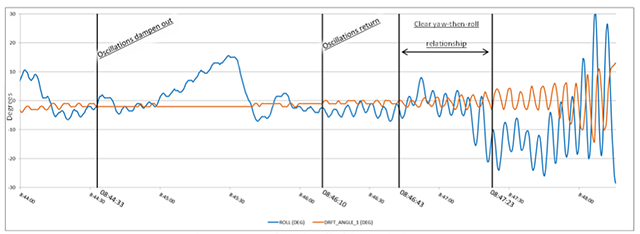
KC-135R 63-8877 Dutch Roll,
from Accident Investigation Report, figure 6.
- In [Figure 6], the blue plot is the [aircraft's] roll and the orange plot is the [aircraft's] drift angle, or yaw. Positive values indicate rolling/yawing to the right and negative values indicate rolling/yawing to the left. Beginning with takeoff at 08:37:23Z, the [aircraft] experienced a series of uncommanded yaw movements that caused the nose of the [aircraft] to oscillate left and right. At around 08:44:33Z, the oscillations dampened out almost entirely, characterized by the flat segment of the orange line in Figure 6. At approximately 08:46:10Z, the [aircraft] resumed the oscillations. The period between 08:46:43Z and 08:47:23Z depicts a clear yawing-then-rolling relationship that is symptomatic of dutch roll. Each “peak” of roll occurs about two seconds after each peak of yaw. In this 40-second time frame, eight peaks equate to a period of about five seconds.
Source: Accident Investigation Report, §5
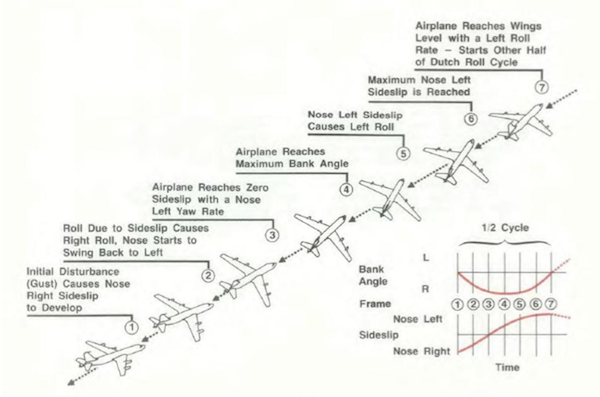
Dutch Roll Illustration, from Accident Investigation Report, figure 7.
- [Figure 7] below illustrates how the KC-135 behaves during dutch roll. The yawing of the aircraft’s nose is known as sideslip. The FDR indirectly measures sideslip as a drift angle. Once the sideslip reaches its peak, the roll develops as depicted in red below in Figure 7. Dutch roll damping is reduced as altitude increases. As the [aircraft] continued to climb, the amplitude of the dutch roll oscillations increased.
Source: Accident Investigation Report, §5
The report underplays just how poorly the KC-135 flies and just how counter intuitive the correction is. All aircraft tend to roll when yawed but for most aircraft the effect of the vertical fin and rudder is to counter this naturally. This is called positive oscillatory stability. As shown in the graph, the rolling motion naturally gets smaller with time.
The KC-135, without the yaw damper, has negative lateral stability. The rolling tendency due to yaw gets worse with time. For more about this: Stability and Control / Dutch Roll.
- Proper dutch roll damping technique is to apply corrective control wheel deflections as the aircraft rolls through wings-level. The damping technique described in the Technical Order (T.O.) 1C-135(K)R(II)-1, KC-135R/T Inflight Data, Change 12, dated 1 April 2012 (Inflight Manual) is to “stop the rising wing at the desired bank angle with aileron. As the wing stops, center the control wheel and prepare to stop the other wing from rising”. [Figure 8] illustrates a properly timed input (green dot), a late input (yellow dot), and an out-of-phase input (red dot). The-out-of-phase input occurs after roll has changed direction, and in turn accelerates roll in the opposite direction instead of dampening the roll.
Source: Accident Investigation Report, §5
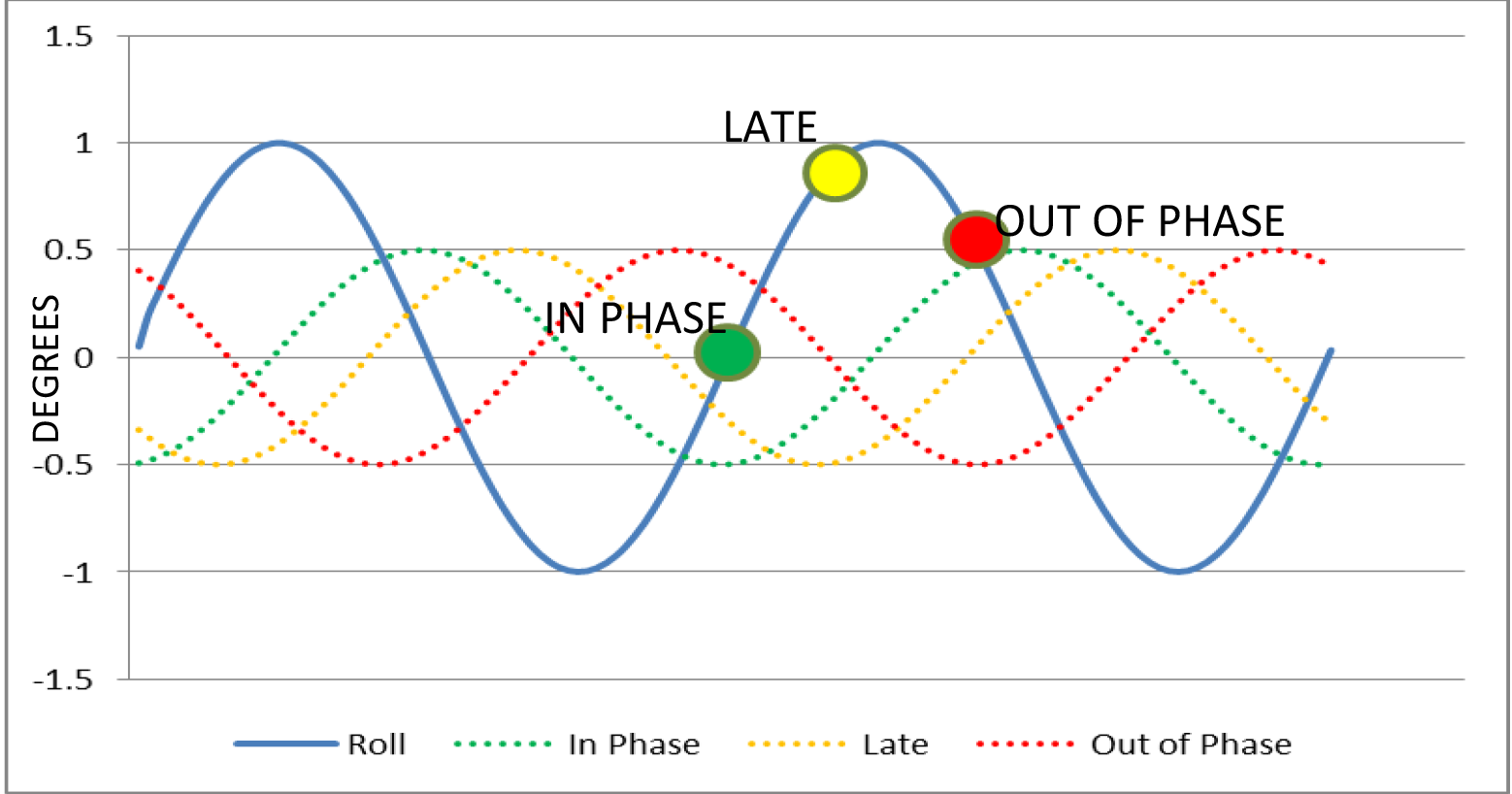
Dutch Roll Illustration, from Accident Investigation Report, figure 8.
Here again the report underplays just how difficult manually damping a dutch roll in the KC-135 can be. The older C-135C manual portends the magnitude of the challenge a little better:
Manual damping of dutch roll is accomplished with the lateral controls only. As a first approximation, use a control wheel input roughly equal to the degree of oscillation. For example, if the bank angle oscillations are +/- 10°, use about 10° of control wheel. Lateral control inputs should not be large and should be centered quickly as the rolling motion stops. If the input is held too long, it may excite another large oscillation in the opposite direction. Several cycles may be required to damp out Dutch roll. The next lateral control input should be delayed until the start of the next bank oscillation and then be applied to stop the rising wing, quickly centering the wheel as the roll stops.
Source: Technical Order 1C-135(E)C-1, pg. 6-15
The training required to learn the technique was intensive and took most pilots four or five flights to get it right. The training had to be done low to the ground, where the dutch roll tendency was at its worse, and there were casualties. See KC-135A 59-1443 for an example of a training flight gone wrong. Since the installation of a yaw damper, KC-135 pilots can go their entire careers without ever seeing a dutch roll.
- Dutch roll recognition and recovery training is only accomplished in the simulator during the Pilot Initial Qualification (PIQ) course and is not re-accomplished in the simulator during upgrade and continuation training. The proficiency level required for dutch roll recognition is “familiarization,” meaning each pilot must only discuss this topic and is not required to perform the maneuver. The KC-135 simulator dutch roll profile is planned in straight and level flight at flight level 390, a gross weight based on 100,000 pounds of fuel and a speed of .77 Mach. The Inflight Manual prohibits pilots from practicing dutch roll recognition and recovery in the aircraft, specifically stating “intentionally-induced dutch roll and aerobatics of any kind are strictly prohibited.”
- Insidious onset of dutch roll is impossible to replicate in KC-135 simulator training due to mechanical limitations. In order to have a flight simulator enter a dutch roll phenomenon, simulator instructors utilize two predominant techniques. The first has one of the pilots push the rudder in about three inches and pop it out and the other involves activating a programmed simulator malfunction, such as hard over-rudder, for a couple seconds, and then take it out which will also induce rolling motions and bank angles of 45 degrees or more roll. The flight simulator dampens dutch roll on its own with little pilot input. The simulator cannot reproduce dutch roll in a continuous motion. Dutch roll recovery procedure calls for ensuring the SYD is on. However, there is no training profile in which the SYD is completely inoperative or where the SYD is providing erroneous inputs. A former KC-135 Instructor Pilot and current simulator operator, who experienced severe dutch roll in flight, confirmed the current simulator training does not reproduce a severe dutch roll.
- The [pilot] did not receive any instruction on dutch roll recognition or recovery procedures during upgrade or continuation training.
Source: Accident Investigation Report, §12
It appears dutch roll is "impossible to replicate in KC-135 simulator training," due to limitations of the simulator itself. I've seen it duplicated in the Challenger 604 simulator to good effect, so it can be done. The facts that this aircraft has negative lateral stability with the yaw damper inoperative, that yaw dampers can fail, and that KC-135 pilot training only requires each pilot need to discuss the topic once and never perform the maneuver, I think, is causal in this accident.
- The Inflight Manual contains a chapter on emergency procedures. This section is arranged in two subsections, within each of these subsections, the procedures are divided into two categories, critical and non-critical. These procedures constitute the minimum required steps to be taken by a crewmember to ensure survival. When an airborne emergency occurs, the following rules always apply: 1) Fly The Airplane: Establish a safe airspeed, attitude, and thrust setting. Maintaining airplane control is paramount. 2) Stop – Think – Collect Your Wits: Make a thorough evaluation of each emergency prior to initiating corrective action.
- The Inflight Manual’s Dutch Roll Recovery Procedures warnings section states that pilots should “not attempt to damp dutch roll manually with the rudder” and “improper excitation and recovery techniques cause higher than normal cumulative stresses in the vertical stabilizer.” Also, the “sudden reversal of rudder direction at high rudder deflections, due to improper rudder application or abrupt release, can result in overstressing the vertical fin.”
Source: Accident Investigation Report, §12
As the report itself indicates, the pilot did not recognize the aircraft's behavior to be dutch roll. I don't think the issue here is that the pilot used the wrong dutch roll mitigation technique, the issue is he wasn't properly taught to recognize it.
- The [pilot] assumed control of the [aircraft] approximately one minute before the [aircraft's] moment of failure. When the [pilot] took control of the [aircraft] it was in a pronounced dutch roll, as shown by widely divergent sine waves. The [pilot] used rudder to roll in and out of a turn at waypoint DW. Additionally, during the turn, the [aircraft] experienced a series of alternating small rudder inputs. These alternating small rudder inputs, caused by the [aircraft's] dutch roll-induced acceleration forces varying the [pilot's] foot pressure on the rudder pedals, sharply increased the dutch roll oscillations. The [pilot's] use of rudder was not in compliance with the Inflight Manual dutch roll procedure and the warnings regarding use of rudder and rudder reversal due to overstressing the vertical fin.
Source: Accident Investigation Report, §12
4
Cause
I was taught to write Air Force Mishap Investigation Reports at the Air Force Safety School in 1985 where the surest way to fail was to write the causal section that tells "what" and not "why." The following report makes that very mistake:
- The cause of the mishap was the [aircraft's] tail section separating due to structural overstress as a result of the [crew's] failure to turn off either the SYD [Series Yaw Damper] or the rudder power and oscillating dutch roll-induced forces translating through the [pilot's] feet as the [pilot] used rudder during the unrecognized dutch roll condition.
- The [crew's] failure to turn off either the SYD or the rudder power was contrary to the Inflight Manual procedure for correcting rudder hunting. Per the Inflight Manual, the procedure is to sequentially disengage the autopilot, EFAS, SYD, and the powered rudder until the oscillations stop. Flight data indicates the SYD was engaged the entire flight. The [crew] deviated from the procedure by leaving the SYD engaged.
- The [pilot's] use of rudder during a dutch roll was contrary to the Inflight Manual that prohibits rudder use in this manner. Rudder movements overstressed the tail section and initiated the [aircraft's] breakup sequence that caused the crash. The rudder inputs of the [pilot] were causal in the failure of the tail section.
- The [pilot] and [copilot] diagnosed a directional control problem as well as a problem with the SYD. The Lateral and Directional Control Difficulty Due To SYD Malfunction and Rudder Hunting sections in the Inflight Manual describe appropriate crew actions in response to these conditions. The Inflight Manual contains warnings that state:
- The [aircraft] was in dutch roll, but still in a flyable condition, when the [pilot] took control of the [aircraft]. In the last minute of the mishap flight, the [pilot] applied and varied the left rudder pressure multiple times, then reversed pressure to the right pedal. These rudder pedal movements, confirmed by the FDR data analysis, reveal the growing sideslip oscillations of the [aircraft] represent the application and multiple variations of left rudder pressure, as well as an abrupt right rudder reversal in the final 10 seconds leading to a progressively increasing sideslip. Due to the timing of the rudder inputs, each peak rudder input occurs in the same direction as the sideslip. Instead of decreasing the sideslip, the [pilot's] rudder pedal movements compounded it. The final rudder input of 11 degrees coincides with the structural failure of the tail section and end the of the FDR / CVR data, about one second before the MA pitches over.
"Manual damping of dutch roll is to be accomplished with lateral (aileron) control. Do not attempt to damp dutch roll manually with the rudder . . . the sudden reversal of rudder direction at high rudder deflections, due to improper rudder application or abrupt release, can result in overstressing the vertical fin. This condition could be brought about during recovery attempts from a flight condition induced by a lateral control malfunction."
Source: Accident Investigation Report, page 49
I would rewrite all of this to emphasize the "why" and not the "what." Every mishap report needs to show why the mishap happened and who failed that caused it to happen. I would say:
- The KC-135R incorporated a yaw damper that eliminated the aircraft's dutch roll tendency.
- Existing in-aircraft dutch roll training was replaced with simulator familiarization discussion.
- CAUSE: The Air Force failed to institute effective KC-135 dutch roll training prior to canceling existing in-aircraft training methods.
- CAUSE: The Air Force failed to properly train its KC-135 pilots on an initial or recurring basis on how to recognize and then mitigate the effects of KC-135 dutch roll.
- When the yaw damper failed in the mishap aircraft, the pilot did not recognize a resulting dutch roll.
- The dutch roll increased in intensity to the point the pilot lost control of the aircraft, which entered a steep dive and was lost, killing the crew of three.
References
(Source material)
Davies, D. P., Handling the Big Jets, Civil Aviation Authority, Kingsway, London, 1985.
Technical Order 1C-135(E)C-1, EC-135C Flight Manual, USAF Series, 15 February 1966.
USAF Aircraft Accident Investigation Board Report, KC-135R, 63-8877, 3 May 2013
